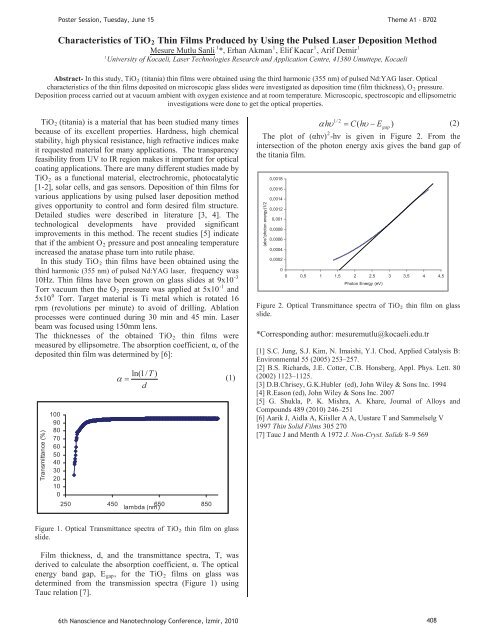Photonic crystals in biology
Photonic crystals in biology
Photonic crystals in biology
Create successful ePaper yourself
Turn your PDF publications into a flip-book with our unique Google optimized e-Paper software.
P Torr.<br />
pressure<br />
P<br />
pressure<br />
P and<br />
P<br />
pressure.<br />
Poster Session, Tuesday, June 15<br />
Theme A1 - B702<br />
Characteristics of TiOR2R Th<strong>in</strong> Films Produced by Us<strong>in</strong>g the Pulsed Laser Deposition Method<br />
1<br />
1<br />
1<br />
1<br />
UMesure Mutlu SanliUP P*, Erhan AkmanP P, Elif KacarP P, Arif DemirP<br />
1<br />
PUniversity of Kocaeli, Laser Technologies Research and Application Centre, 41380 Umuttepe, Kocaeli<br />
Abstract- In this study, TiOR2R (titania) th<strong>in</strong> films were obta<strong>in</strong>ed us<strong>in</strong>g the third harmonic (355 nm) of pulsed Nd:YAG laser. Optical<br />
characteristics of the th<strong>in</strong> films deposited on microscopic glass slides were <strong>in</strong>vestigated as deposition time (film thickness), OR2R<br />
Deposition process carried out at vacuum ambient with oxygen existence and at room temperature. Microscopic, spectroscopic and ellipsometric<br />
<strong>in</strong>vestigations were done to get the optical properties.<br />
TiOR2 R(titania) is a material that has been studied many times<br />
because of its excellent properties. Hardness, high chemical<br />
stability, high physical resistance, high refractive <strong>in</strong>dices make<br />
it requested material for many applications. The transparency<br />
feasibility from UV to IR region makes it important for optical<br />
coat<strong>in</strong>g applications. There are many different studies made by<br />
TiOR2R as a functional material, electrochromic, photocatalytic<br />
[1-2], solar cells, and gas sensors. Deposition of th<strong>in</strong> films for<br />
various applications by us<strong>in</strong>g pulsed laser deposition method<br />
gives opportunity to control and form desired film structure.<br />
Detailed studies were described <strong>in</strong> literature [3, 4]. The<br />
technological developments have provided significant<br />
improvements <strong>in</strong> this method. The recent studies [5] <strong>in</strong>dicate<br />
that if the ambient OR2R and post anneal<strong>in</strong>g temperature<br />
<strong>in</strong>creased the anatase phase turn <strong>in</strong>to rutile phase.<br />
In this study TiOR2R th<strong>in</strong> films have been obta<strong>in</strong>ed us<strong>in</strong>g the<br />
third harmonic (355 nm) of pulsed Nd:YAG laser, frequency was<br />
-3<br />
10Hz. Th<strong>in</strong> films have been grown on glass slides at 9x10P<br />
-1<br />
Torr vacuum then the OR2R was applied at 5x10P<br />
0<br />
5x10P Target material is Ti metal which is rotated 16<br />
rpm (revolutions per m<strong>in</strong>ute) to avoid of drill<strong>in</strong>g. Ablation<br />
processes were cont<strong>in</strong>ued dur<strong>in</strong>g 30 m<strong>in</strong> and 45 m<strong>in</strong>. Laser<br />
beam was focused us<strong>in</strong>g 150mm lens.<br />
The thicknesses of the obta<strong>in</strong>ed TiOR2R th<strong>in</strong> films were<br />
measured by ellipsometre. The absorption coefficient, , of the<br />
deposited th<strong>in</strong> film was determ<strong>in</strong>ed by [6]:<br />
Transmittance (%)<br />
100<br />
90<br />
80<br />
70<br />
60<br />
50<br />
40<br />
30<br />
20<br />
10<br />
0<br />
ln(1/ T )<br />
(1)<br />
d<br />
250 450 650 850<br />
lambda (nm)<br />
<br />
1/2<br />
h C h<br />
E gap<br />
( )<br />
(2)<br />
2<br />
The plot of (h)P P-h is given <strong>in</strong> Figure 2. From the<br />
<strong>in</strong>tersection of the photon energy axis gives the band gap of<br />
the titania film.<br />
(abs*photon energy)1/2<br />
0,0018<br />
0,0016<br />
0,0014<br />
0,0012<br />
0,001<br />
0,0008<br />
0,0006<br />
0,0004<br />
0,0002<br />
0<br />
0 0,5 1 1,5 2 2,5 3 3,5 4 4,5<br />
Photon Energy (eV)<br />
Figure 2. Optical Transmittance spectra of TiOR2R th<strong>in</strong> film on glass<br />
slide.<br />
*Correspond<strong>in</strong>g author: mesuremutlu@kocaeli.edu.tr<br />
[1] S.C. Jung, S.J. Kim, N. Imaishi, Y.I. Chod, Applied Catalysis B:<br />
Environmental 55 (2005) 253–257.<br />
[2] B.S. Richards, J.E. Cotter, C.B. Honsberg, Appl. Phys. Lett. 80<br />
(2002) 1123–1125.<br />
[3] D.B.Chrisey, G.K.Hubler (ed), John Wiley & Sons Inc. 1994<br />
[4] R.Eason (ed), John Wiley & Sons Inc. 2007<br />
[5] G. Shukla, P. K. Mishra, A. Khare, Journal of Alloys and<br />
Compounds 489 (2010) 246–251<br />
[6] Aarik J, Aidla A, Kiisller A A, Uustare T and Sammelselg V<br />
1997 Th<strong>in</strong> Solid Films 305 270<br />
[7] Tauc J and Menth A 1972 J. Non-Cryst. Solids 8–9 569<br />
Figure 1. Optical Transmittance spectra of TiOR2R th<strong>in</strong> film on glass<br />
slide.<br />
Film thickness, d, and the transmittance spectra, T, was<br />
derived to calculate the absorption coefficient, . The optical<br />
energy band gap, ERgapR, for the TiOR2R films on glass was<br />
determ<strong>in</strong>ed from the transmission spectra (Figure 1) us<strong>in</strong>g<br />
Tauc relation [7].<br />
6th Nanoscience and Nanotechnology Conference, zmir, 2010 408













